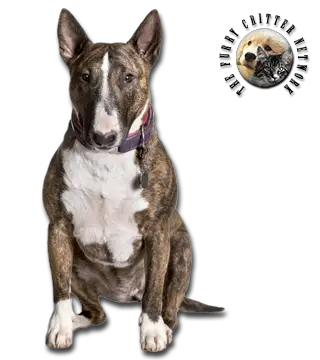Breed Standard
Head: Long, strong, oval (egg-shaped). Top of skull is almost flat. No stop. Strong lower jaw.
Ears: Small, thin leather, close set. Held erect.
Eyes: Appear narrow, set obliquely in the skull, triangular. Black or very dark brown color (the darker the better).
Body: Massive. Very muscular neck. Broad, deep chest. Ribs well sprung. Broad heavily muscled loin. Short, extremely muscular back.
Tail: Short, set low, carried horizontally. Thick at the root and tapering to a thin tip.
Hair: Short; flat, hard with tight-fitting skin. Soft undercoat in winter.
Coat: Whites have solid white coat; pigmentation of the skin and markings on the head are not faults. In colored varieties, color must be dominant over the white. Black brindle, red, fawn and tri-color are acceptable.
Size: No limit.
Weight: No limit. Miniature Bull Terriers must measure 35,5 cm (14 in) or less and weigh 9 kg (20 lb) or less. The head is foxlike, with a slightly domed, broad skull. The stop is pronounced and the muzzle is chiselled. Tight lips.
History
The Bull Terrier was bred from crosses of Bulldogs with Terriers to create the "gladiator of the dog race". The new breed was first used for bull-baiting then for dog fighting. In 1835, this practice was outlawed. The Bull Terrier's silhouette was refined around 1860. A white variety was selectively bred, giving birth to the modern breed. The Bull Terrier was recognized by The Kennel Club in 1933.
Behavior
Bull Terriers are known to be courageous and active. They enjoy being around people but are strong willed and thus require an assertive owner; as such the Bull Terrier is not recommended for households with small children if the owner is a first time Bull Terrier owner. Bull Terriers need the companionship of their owners and should not be kept outside in a kennel. Bull Terriers can be both independent and stubborn and for this reason are not considered suitable for an inexperienced dog owner. A firm hand and an assertive demeanour are essential if the Bull Terrier is not to run riot. They are protective of their family, although comprehensive socialization at an early age will prevent them from becoming over-protective and neurotic.
When it comes to other animals, caution should be advised. Bull Terriers have a strong prey instinct and, like any strong dog breed, can cause injury or death to people or other animals, especially cats. That said, puppies brought up with cats and other animals get on well with the animals they know; however, they can never be completely trusted with other animals. Uncastrated males often do not get along with other male dogs. Males and females however can live together happily, and two females can also be a good combination with care and supervision. Introducing a Bull Terrier of the same sex as the dog in residence is considered unwise, and some Bull Terriers won't countenance other dogs of either sex.
This breed adapts well to life as a house dog but does not like to be left alone and requires plenty of exercise. Weekly brushing is required.
Function
Guard Dog, Pet.
Health
Prone to slipped patella (dislocation of the kneecaps), heart defects, kidney failure and skin and flea allergies. Prone to suffer from a zinc deficiency, which can cause death. Gains weight easily. Do not overfeed. White Bull Terriers are prone to deafness.






